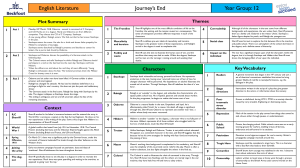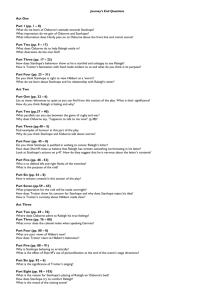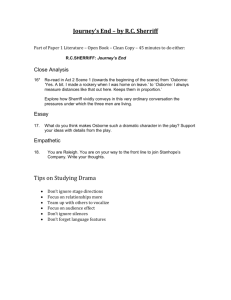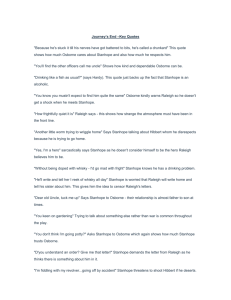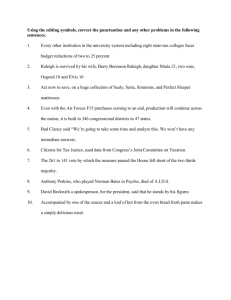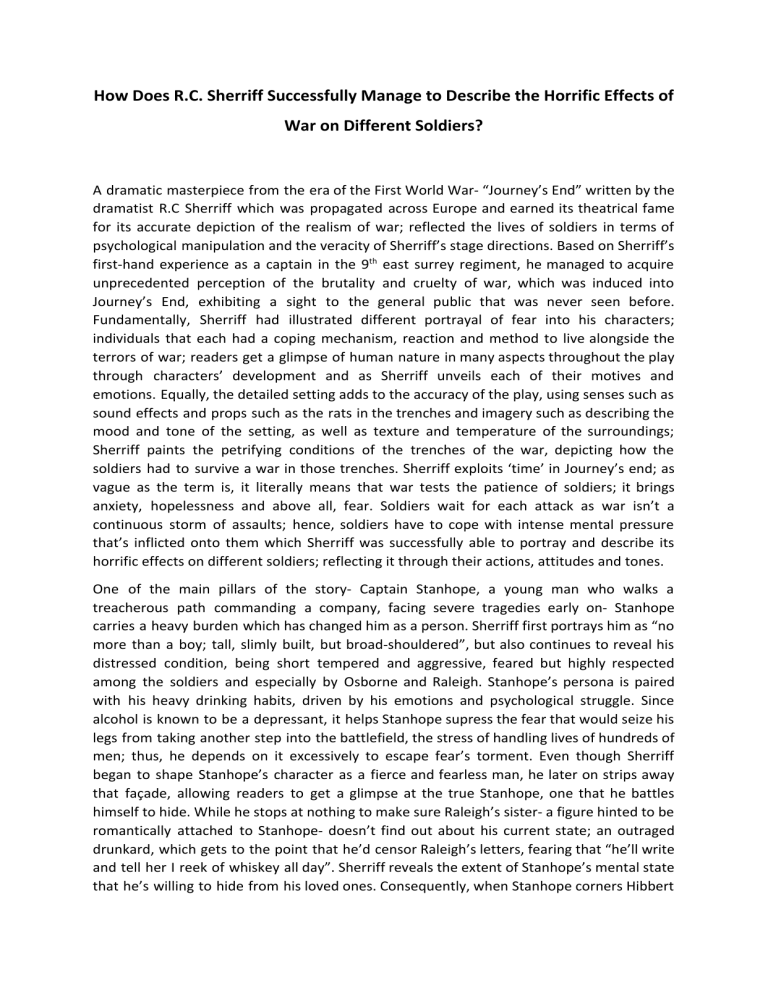
How Does R.C. Sherriff Successfully Manage to Describe the Horrific Effects of War on Different Soldiers? A dramatic masterpiece from the era of the First World War- “Journey’s End” written by the dramatist R.C Sherriff which was propagated across Europe and earned its theatrical fame for its accurate depiction of the realism of war; reflected the lives of soldiers in terms of psychological manipulation and the veracity of Sherriff’s stage directions. Based on Sherriff’s first-hand experience as a captain in the 9th east surrey regiment, he managed to acquire unprecedented perception of the brutality and cruelty of war, which was induced into Journey’s End, exhibiting a sight to the general public that was never seen before. Fundamentally, Sherriff had illustrated different portrayal of fear into his characters; individuals that each had a coping mechanism, reaction and method to live alongside the terrors of war; readers get a glimpse of human nature in many aspects throughout the play through characters’ development and as Sherriff unveils each of their motives and emotions. Equally, the detailed setting adds to the accuracy of the play, using senses such as sound effects and props such as the rats in the trenches and imagery such as describing the mood and tone of the setting, as well as texture and temperature of the surroundings; Sherriff paints the petrifying conditions of the trenches of the war, depicting how the soldiers had to survive a war in those trenches. Sherriff exploits ‘time’ in Journey’s end; as vague as the term is, it literally means that war tests the patience of soldiers; it brings anxiety, hopelessness and above all, fear. Soldiers wait for each attack as war isn’t a continuous storm of assaults; hence, soldiers have to cope with intense mental pressure that’s inflicted onto them which Sherriff was successfully able to portray and describe its horrific effects on different soldiers; reflecting it through their actions, attitudes and tones. One of the main pillars of the story- Captain Stanhope, a young man who walks a treacherous path commanding a company, facing severe tragedies early on- Stanhope carries a heavy burden which has changed him as a person. Sherriff first portrays him as “no more than a boy; tall, slimly built, but broad-shouldered”, but also continues to reveal his distressed condition, being short tempered and aggressive, feared but highly respected among the soldiers and especially by Osborne and Raleigh. Stanhope’s persona is paired with his heavy drinking habits, driven by his emotions and psychological struggle. Since alcohol is known to be a depressant, it helps Stanhope supress the fear that would seize his legs from taking another step into the battlefield, the stress of handling lives of hundreds of men; thus, he depends on it excessively to escape fear’s torment. Even though Sherriff began to shape Stanhope’s character as a fierce and fearless man, he later on strips away that façade, allowing readers to get a glimpse at the true Stanhope, one that he battles himself to hide. While he stops at nothing to make sure Raleigh’s sister- a figure hinted to be romantically attached to Stanhope- doesn’t find out about his current state; an outraged drunkard, which gets to the point that he’d censor Raleigh’s letters, fearing that “he’ll write and tell her I reek of whiskey all day”. Sherriff reveals the extent of Stanhope’s mental state that he’s willing to hide from his loved ones. Consequently, when Stanhope corners Hibbert in Act 2, Scene 2, he attempts to threaten Hibbert for desertion, claiming that he’d have to shoot him; to which Hibbert demands that he’d rather be shot instead of going back to the battlefield. As Hibbert faces Stanhope, quivering, he learns about Stanhope’s psychological traumas and his internal battles; hence, Stanhope confesses- “I hate and loathe it all. Sometimes I feel I could just lie down on this bed and pretend I was paralysed or somethingand couldn’t move- and just lie there till I died- or was dragged away”; as this point made Hibbert come to realization with his fate. Sherriff’s stage directions show the audience the strength of the soldiers as they both head out to the battlefield despite the misery that continues to eat them away, testing their sanity but empowering their comradeship. Sherriff also proves how war can taint the purest and most determined individual; the next pillar to the story known as Raleigh. A fresh soldier, seen as the most enthusiastic and a very keen character in the play, young Raleigh was a model soldier that the wars needed, but was that courage and honour enough to help him survive the deadly trenches? His concept of war was what fascinated him, which also intrigued Osborne as to how he idealized the concept of warfare almost romantically, driving him to “put up a good show” for the fatal raid, finding it “most frightfully exciting later on”. Using stage directions, Sherriff emphasizes Raleigh’s body language to enhance his emotions and convey it to the audience. For example, Raleigh would have a particularly awkward body language upon his first meeting with Osborne, though Sherriff also hints at his clumsiness through Raleigh’s dialogue; mainly through his stutters and excitement in speech. Unfortunately, it didn’t take long before a shred of his excitement got torn down after being warned that his idol- Stanhope; whom he looked up to highly was a different person compared to the one he knew, which is evident to prove the effects of war on soldiers, even the strongest. Sherriff demonstrated how merciless war was even for Raleigh, after his raid with Osborne to capture a German; where Raleigh tasted the reality of war, an undeserving death. Faced with despair and terror, Sherriff intensified the dreading of loss with skilful stage directions, amplifying sound effects, backdrops and body language; intensifying the menace of the battlefield with the sorrow of the deceased. With bloody hands and a lowered head, he brought forth the news to Stanhope, forced to tell him that his only friend is gone; that was enough to shatter Raleigh’s enthusiasm. Similarly, the last calamitous tragedy in the play would be the closing scene; which contains one of the most detailed stage directions describing the atmosphere“The grey night sky is dissolving and the stars begin to go”, possibly foreshadowing Raleigh’s life-force; also depicting Stanhope’s love and care for Raleigh as he “bathes the boy’s face” and continues to remain by his side until the end. Sheriff conveyed the futility of war into those scenes, reflecting his experiences into the tragedy, etching real, painful emotions into them. War is known to be merciless, and Sherriff was to prove that to the world with Journey’s end. His intricate writing was enough to affect readers, conveying emotions and pain; depicting effects on human psychology with each of the characters in the playwright. The tragic-comedy was very impactful in my opinion, which I believe was only possible by RC Sherriff’s stunning writing, stage direction and character design.
